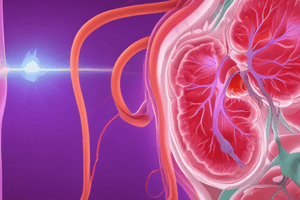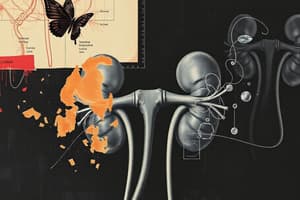Podcast
Questions and Answers
During a renal system assessment, what assessment technique is typically performed before palpation and percussion?
During a renal system assessment, what assessment technique is typically performed before palpation and percussion?
- Auscultation (correct)
- Inspection
- Mensuration
- Olfaction
When inspecting a patient as part of a renal system assessment, which observation provides the most direct information about a patient's hydration status?
When inspecting a patient as part of a renal system assessment, which observation provides the most direct information about a patient's hydration status?
- Inspecting the tongue and mucous membranes. (correct)
- Assessing skin color on the extremities.
- Assessing facial expression.
- Observing the patient's position in bed.
A nurse auscultates over the umbilicus and notices a blowing sound. What condition does this most likely indicate?
A nurse auscultates over the umbilicus and notices a blowing sound. What condition does this most likely indicate?
- Bladder distention.
- Urinary tract infection.
- Renal artery stenosis. (correct)
- Normal bowel peristalsis.
When percussing the kidneys to check for costovertebral angle (CVA) tenderness, what does CVA tenderness typically indicate?
When percussing the kidneys to check for costovertebral angle (CVA) tenderness, what does CVA tenderness typically indicate?
During percussion of the bladder, a nurse notes a dull sound. What does this finding suggest?
During percussion of the bladder, a nurse notes a dull sound. What does this finding suggest?
Why is the patient instructed to inhale deeply when palpating the right kidney?
Why is the patient instructed to inhale deeply when palpating the right kidney?
Which action is performed to palpate the left kidney?
Which action is performed to palpate the left kidney?
Under what conditions would the urinary bladder be palpated?
Under what conditions would the urinary bladder be palpated?
What does the presence of bruising on the extremities and trunk during an inspection suggest?
What does the presence of bruising on the extremities and trunk during an inspection suggest?
A patient reports pain during CVA percussion. Which condition is most likely?
A patient reports pain during CVA percussion. Which condition is most likely?
What does asymmetry observed during an inspection of the renal system typically indicate?
What does asymmetry observed during an inspection of the renal system typically indicate?
During palpation, the kidneys are typically not palpable. What does it indicate when they are palpable?
During palpation, the kidneys are typically not palpable. What does it indicate when they are palpable?
A healthcare provider begins percussion at the symphysis pubis and moves upward and outward. What is the purpose of this technique?
A healthcare provider begins percussion at the symphysis pubis and moves upward and outward. What is the purpose of this technique?
Which abnormal sound resembles a blowing or swishing noise and may indicate diminished blood flow to the kidney?
Which abnormal sound resembles a blowing or swishing noise and may indicate diminished blood flow to the kidney?
What is the significance of assessing the level of consciousness during the inspection phase of a renal system assessment?
What is the significance of assessing the level of consciousness during the inspection phase of a renal system assessment?
What is the purpose of auscultating the renal arteries during a renal system assessment?
What is the purpose of auscultating the renal arteries during a renal system assessment?
Which aspect of patient hygiene is considered during the inspection phase of a renal system assessment?
Which aspect of patient hygiene is considered during the inspection phase of a renal system assessment?
When percussing the bladder, what action should a nurse take if a patient reports significant discomfort?
When percussing the bladder, what action should a nurse take if a patient reports significant discomfort?
During percussion of the kidneys, a nurse strikes the area indirectly by placing one hand flat on the costovertebral angle and using the fist of the other hand to strike it. What is the rationale for this technique?
During percussion of the kidneys, a nurse strikes the area indirectly by placing one hand flat on the costovertebral angle and using the fist of the other hand to strike it. What is the rationale for this technique?
What does "signs of distress" refer to during inspection?
What does "signs of distress" refer to during inspection?
Flashcards
Inspection
Inspection
Visual examination of the patient's general condition for signs of health or illness.
Auscultation
Auscultation
Listening to internal body sounds, often using a stethoscope.
Percussion
Percussion
Tapping the body to evaluate the size, borders, and consistency of internal organs and to detect fluid or air in body cavities.
Palpation
Palpation
Signup and view all the flashcards
Renal Bruit
Renal Bruit
Signup and view all the flashcards
CVA Tenderness
CVA Tenderness
Signup and view all the flashcards
Tympany Sound
Tympany Sound
Signup and view all the flashcards
Distended bladder
Distended bladder
Signup and view all the flashcards
Study Notes
- Assessment of the kidney, ureters, and bladder occurs during abdominal examination
- Auscultation should be done before palpation and percussion
Inspection
- Observe the patient's overall appearance, including facial expression, height and weight, position in bed, grooming, patient hygiene, signs of distress, and level of consciousness
- Assess the skin of the extremities and trunk for color, bruising, or bleeding
- Inspect the tongue and mucous membranes to assess hydration status
- Inspect the flank region while the patient is sitting and supine
- Observe for asymmetry (swelling) or discoloration
Auscultation
- Auscultate the renal arteries for bruits
- Place the stethoscope above the umbilicus, then to the left and right of the umbilicus
- A renal bruit may indicate renal artery stenosis, which may result from diminished blood flow to the kidney
- A bruit is an abnormal blowing or swishing sound, similar to a cardiac murmur
Percussion
- Percuss the kidney to check for costovertebral angle (CVA) tenderness, which may occur with inflammation
- Ask the patient to sit up
- Place one hand over the posterior costovertebral angle at the 12th rib
- Gently percuss the CVA and note any discomfort
Percussion of the Bladder
- Ask the patient to empty their bladder
- Place the patient in the supine position
- Begin percussion at the symphysis pubis and move upward and outward to estimate bladder size
- Normally, a tympanic sound is heard when percussing the bladder
- A dull sound may indicate retained urine
Palpation
- The kidneys are normally not palpable unless they are enlarged
- If the kidney feels enlarged, the patient may have cysts or tumors
Palpation of Right Kidney
- Place the patient in the supine position
- Stand on the right side of the patient
- Place your left hand between the posterior rib cage and the iliac crest
- Place your right hand on the patient's abdomen
- Instruct the patient to inhale deeply so their kidney moves downward
- As the patient inhales, press up with your left hand and down with your right
Palpation of Left Kidney
- Reach across the patient's abdomen
- Place your left hand behind their left flank
- Place your right hand over the area of the left kidney
- Ask the patient to inhale deeply
- Pull up with your left hand and press down with your right
Palpation of Urinary Bladder
- Palpate for a distended bladder if the patient's history or other findings warrant it, like dull percussion over the symphysis pubis
- Begin at the symphysis pubis and move upward and outward to estimate the bladder borders
- Normally, an empty bladder is neither palpable nor tender
Studying That Suits You
Use AI to generate personalized quizzes and flashcards to suit your learning preferences.




